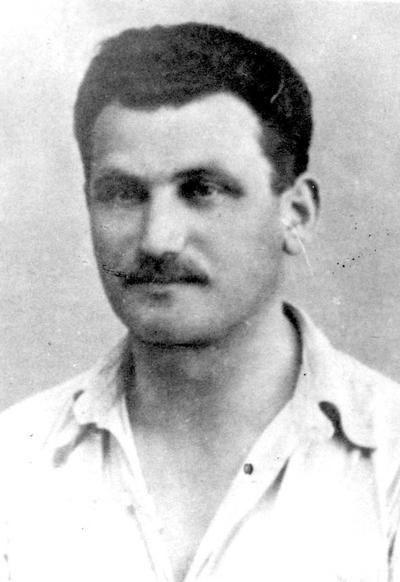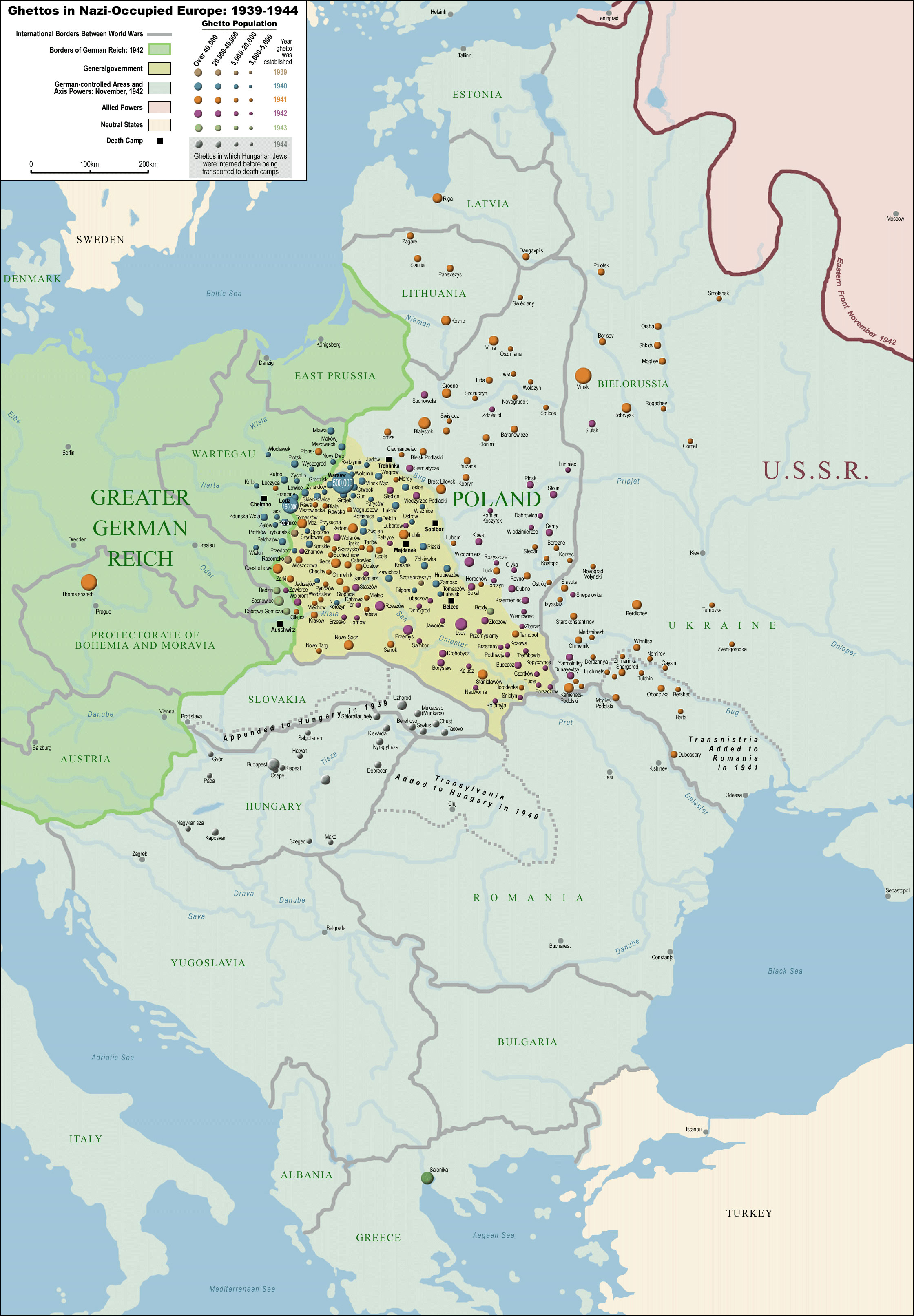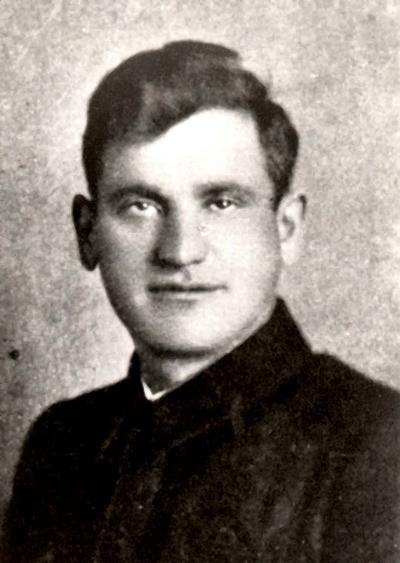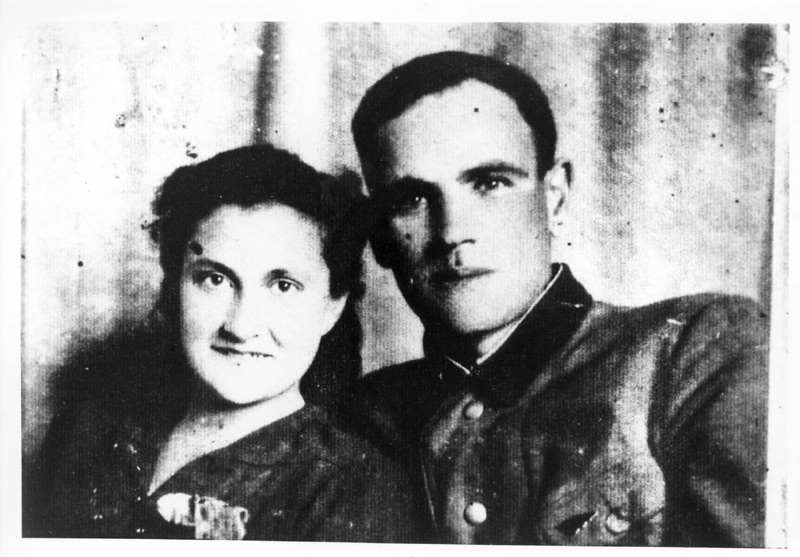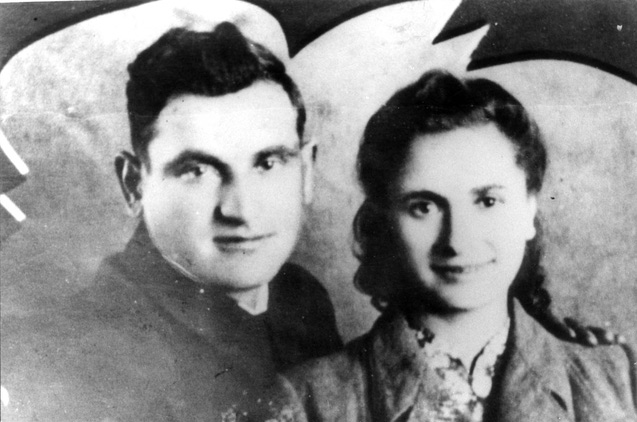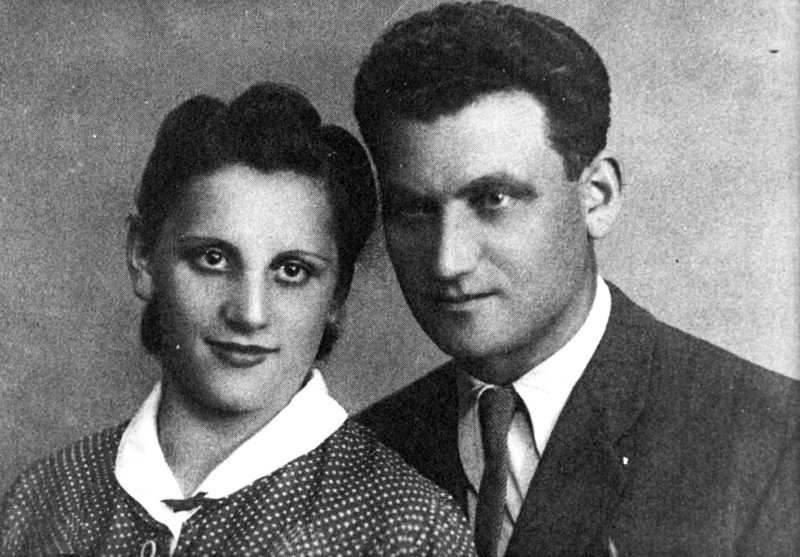“Don’t rush to fight and die. So few of us are left, we need to save lives. It is more important to save Jews than to kill Germans.”1
Tuvia Bielski
Introduction
The first question that comes to mind when discussing the subject of Jewish solidarity during the Holocaust is: how? Surrounded by humiliation, exploitation, hardships, loss and death, how was it possible for people to stay human and show solidarity for other human beings? The Holocaust challenged established social norms, values and relationships. In a reality in which each individual Jew was subject to persecution and murder, how were people able to reach out to others instead of caring only for their own survival? There are many examples of Jews who risked their lives to save other Jews – either spontaneously by following their instincts as events occurred or by a thought process often involving planning and ideological values. These examples indicate the importance of community and solidarity for people’s survival, as it helped people endure the atrocities and losses. One of the most inspiring and extraordinary stories of Jewish solidarity is the story of the Bielski brothers who built a family camp in the forest of Western Belarus and saved the lives of around 1,200 Jews. The story brings to light the significance of human solidarity that was still possible even in the face of the surrounding atrocities.
The beginning of a partisan unit
“There was something familiar about the forest, and in the worst case we could escape among the trees.”2
The four brothers Tuvia, Asael, Zusya and Aharon Bielski grew up in Eastern Poland, now Western Belarus, which had been annexed by the Soviet Union in 1939. They lived in the village Stankiewicze located between the towns Lida and Nowogródek. It had been the home of the Bielski family for three generations. They were the only Jewish family in a village that was populated by six families. They farmed the land and owned a mill. Their parents, David and Beila, had twelve children – ten sons and two daughters. Tuvia, the second-oldest child, was born in 1906.
In June, 1941 German troops invaded the Soviet Union. They were followed by Einsatzgruppen, killing squads, which rounded up the Jews, murdered them in mass graves and forced the remaining Jewish population into ghettos.
After their parents and other relatives were murdered in a massacre of around 5,000 Jews on December 8, 1941, the Bielski brothers fled to the Belarusian forest and set up a partisan unit with Tuvia Bielski as the commander. However, unlike other partisan groups, fighting the enemy was not their highest goal. Their primary objective was to rescue Jews and to offer them shelter and protection in the forest. The brothers did not only admit those who were able to fight, but every Jewish woman or man, no matter whether the person was young or old, healthy or sick, a fighter or a noncombatant. Tuvia Bielski explained that he “… would rather save one old Jewish woman, than kill ten German soldiers.”3
However, it was not enough to take in Jews that came to the camp.
“We cannot simply hide ourselves. We must do something for our people. We cannot sit in the bushes and wait until the wolf comes for us. We must send people to the ghettos to save Jews.”4
Thus, fighters were sent to the ghettos and hiding places of the towns of Nowogródek and Lida to convince people to escape from the ghettos and to join the brothers in the forest.
This was not an easy task. Many ghetto inmates were not interested in leaving the ghetto. Unlike the Bielski brothers who were familiar with the forest given that they had lived in it all their lives, most city or town people had no idea how to live in the woods. They wondered how one could live in the forest among trees, swamps, wild animals and mosquitoes. Some feared spending the harsh winters in the forest; others did not want to leave their families behind. Some were afraid of taking such a risk; others believed they would survive if they continued working for the Germans. They also felt that no further massacres would occur since the remaining population consisted of skilled workers.
Furthermore, each person escaping the ghetto endangered the lives of the remaining population. Some people feared the revenge of the Germans even more than they feared the hunger and the cold of the forests. They also did not believe that fighting the Germans would change the course of history – What could a few partisans do against an army that conquered all of Europe?
Moreover, Tuvia had been in the Polish army, and had military training, whereas most people from the towns did not know how to use a rifle. Thus it was not an easy decision to go to the forest, fight Germans, Polish and Belarusian peasants and partisans, and look for food.
The Judenrat, the Jewish council, and the Jewish police tried to prevent escapes from the ghetto. They feared that the whole population would be executed if a single Jew was missing as the Germans often collectively punished not only those they caught trying to escape, but also others living in the ghetto. Despite these fears and threats, escapes were attempted frequently. Many came to the conclusion that they would be killed anyway and preferred to die on their own terms. In the forest people were at least free and had an opportunity to resist, whereas in the German-controlled areas they were unable to do so. The brothers had received weapons from a Russian partisan unit and were therefore able to protect themselves and the unarmed. Zorach Arluk who became a partisan in a Russian partisan group insists:
“If someone tells you that when he went to the partisans he was motivated by a desire to take revenge, that is incorrect. All of us left the ghetto in the hope of staying alive. We hoped just for a chance. And if not to survive, at least one wanted to die differently from the way most Jews were dying. Not to be shot in a mass grave and not to go to a concentration camp. I think that these motivations were similar for all who ran away from the ghetto. They did not leave to fight, they left to live.”5
The ones that had decided to escape had to slip through fences, holes and tunnels and walk through the countryside to the forest camp.
Some people found their own way into the forest. Because of the constant movement of the Bielski group especially during the first year, special scouts were sent out to look for people.
But for many escapees, the house of gentile peasants served as a way station. There they were given food and a place to rest before members of the Bielski group would come to lead them to the base. The group was dependent on their gentile neighbors without whom they would not have been able to survive. They helped the Jewish group regarding food, information, passing on messages to people in hiding or in the ghettos and hiding escapees. Among the gentile neighbors were Konstantin Kozlovskiy, and his sons Gennadiy and Vladimir, who saved many Jewish lives. They received the title of Righteous Among the Nations.
In the forest the new members had to learn to adapt to their new surrounding in nature, which was important for their survival.
Sulia Rubin remembers:
“It was rough. It was difficult to get accustomed to it, because it was completely different from a protected home and wonderful parents.”6
For others, reaching the Bielski group symbolized freedom. Charles Bedzow remembers when he first saw Tuvia Bielski after escaping the Lida ghetto:
“He was, to me, the biggest hero in the world. After the ghetto and the killing, after living from hour to hour when we didn’t know when the Germans would take us away, it was incredible. It was freedom.”7
Challenges and Dilemmas in the Forest
“We have come here into the forest, my dear ones, not to eat and drink and enjoy ourselves. We have come here, every one of us, to stay alive.”8
As the Bielski group grew bigger they faced different challenges and dilemmas.
The most pressing challenge for the fugitives was procuring enough food for the whole community. It became a fulltime occupation. Young armed men were organized into small squads and put in charge of collecting food from peasants. The dilemma was to find out which peasant was trustworthy and would be able and willing to provide them with food. The Belarusian farmers were struggling to supply the Germans, and the Soviet partisans also confiscated food for themselves.
One partisan argues:
“A partisan was something between a hero and a robber. We had to live and we had to deprive the peasants of their meager belongings. These natives were punished by the Germans and by us… At least if they were all pro-German it would have been easier. This usually was not the case. Often we took by force from poor peasants who were not even pro-Nazi.”9
Other peasants refused to hand over their food to Jews, and sometimes informed the German authorities of Jewish partisans in the forests.
Protecting the camp from intruders, defending themselves against Germans and the local police was equally important. For this purpose camp members were set up as guards. All adults were required to do guard duty, except for the sick, the handicapped and the elderly. Other small squads were sent out on dangerous missions to rescue Jews from the ghettos. In order to protect the camp and rescue Jews the members of the Bielski group needed to acquire weapons. Other partisan groups or friendly peasants provided them with arms; many were also obtained through attacks against German outposts and troops.
Spending the harsh Belarusian winters with its freezing temperatures in the forest was deadly, and the challenge was to keep people from freezing to death and to deal with the members’ health problems. One solution was the construction of insulated structures. Members of the Bielski camp cut down trees and dug holes. The surface of the roof was packed with dirt, branches, and vegetation to camouflage the structure from intruders. In the dugout there were lines of wooden bunks, usually covered with straw. At the beginning of 1943 the group consisted of about three hundred people and additional dugouts were constructed. Close to each one of them was a campfire to warm the people and cook food.
Besides these challenges, the group also had to fight for their position in the forest among the non-Jewish partisans. Many Russian partisan groups were formed in the area as a result of the fast-retreating Red Army and the fast and unexpected attack of the Germans and their quick advance in 1941. Some of these Soviet partisans were suspicious of the Bielski partisans because they were a purely Jewish group with many noncombatants. Even though the cooperation was not always easy, the Bielski brothers worked together with Russian partisans against the Germans. They combined forces with the partisan unit of Viktor Panchenkov, a soldier who had served in the Red army and whose unit was overrun when the Nazis invaded in June 1941. The Bielski group became an official participant in the Soviet war effort. Several attempts by Soviet commanders to absorb Bielski fighters into their units were resisted, and the Jewish partisan group kept its integrity and remained under Tuvia Bielski's command. This allowed the group to continue in their primary mission to protect Jewish lives.
By March, 1942 they started their first operations against Nazis and local collaborators.
As more Jews joined the group the Bielski brothers had to deal with internal problems and decisions. The challenge was how to deal with opposition and internal struggle within the group and to keep a group structure. The group consisted of a diverse variety of people with different social backgrounds, religious and political beliefs.
Some people complained about the way the group was governed, and opposed the leadership of the Bielski brothers, others complained about the way the food was distributed among the members.
Even though the group differed from the average partisan group, the brothers maintained a strict military-style. This structure of total control of the Bielski brothers kept the group united and gave its members a better chance of survival. But it also elevated the importance of those involved in food and sabotage missions. These armed men had privileges such as better food and accommodation.
Another dilemma was the question of how many more people would be allowed to join the group. How many more people should be taken in who were unable to work or fight?
This would not only increase the burden placed on the armed fighters responsible for protection and finding food for the community, but also the likelihood of being discovered, as the group grew bigger. This again meant that they had to put themselves in more dangerous situations and had to deal with more gentile peasants. Even though not everybody agreed with Tuvia Bielski and his views resulted in arguments, he continued to accept more Jews.
Protection against German attacks
“What will we be able to do with so few arms against such a strong and fearsome enemy?”10
The most fearsome enemies, however, were the Germans and the local police.
In December 1942, the Germans launched the first of several major offensives in the forest and the Bielski group had to discuss protection. In the first months they had been constantly moving from one forest to another. Due to the harsh winters they started to construct more permanent camps, which they now needed to evacuate in case of a German attack.
The first evacuation took place in February 1943 when a pro-Nazi police force found the Bielski refuge in the Zabelovo forest through a trail of blood from an animal the fighters had caught. After one guard was killed, another opened fire against the police force. An immediate evacuation was ordered and the people in the forest base were urged to run deeper into the forest. The deserted Zabelovo base was destroyed and ransacked by the police and the camp members were scattered. Fearing another attack, the group decided to relocate and in April they moved to Stara-Huta, a forest near the brothers’ home village Stankiewicze.
The rapid growth of the camp’s population made it widely known and the group was again concerned about its safety and decided to move to a different location. The moving was a problem in itself as it was hard for the members – for the old, the sick and the children - to move and for the armed ones to protect them.
Before they were able to carry out their plans, they were caught by surprise when a German unit made their way into the forest in July 1943. The Germans had started another big offensive. They sent 52,000 soldiers to the forest to launch an extensive hunt and to liquidate all partisans in the forest. This operation was called “Hermann”. German troops surrounded the forest and the Luftwaffe planes began circling around.
The group left, abandoning everything they had collected over the last months. They gathered the group near the Neman River and decided to move to the Naliboki Puscha, about thirty kilometers to the east of Nowogródek, a forest filled with swampland in which it was difficult to find one’s way around. Before that they had kept close to the villages, now they were entering territory that was hard to penetrate. The dilemma they faced was transferring to an area in which they might be able to live more safely, but which they did not know. In order to do so, they had to leave behind the familiar forests and helpful peasants and informers. In a desperate rescue attempt, the Bielski brothers led the approximately 800 members through miles of swamps to an isolated island, called Krasnaya Gorka, in the center of the forest.
Tuvia Bielski describes:
“The children were carried on our shoulders. The people with the children went up front. The swamp began several hundred meters from our camp. It deepened as we progressed. The mud thickened and stuck to us. However, there was no fear of meeting anyone in the swamp. The stronger ones and the ones carrying arms walked last. In some spots we sank up to our navels, though this was not for long distances. We finally crossed, but by supreme effort. The water became more shallow. After each deep spot we had to stop and check, to make sure that everyone had crossed safely. We made very slow progress in the water and mud, it took three hours to cover a distance of three kilometers.”11
Chaja Bielski, Asael Bielski’s wife remembers:
“The more we walked the deeper the mud was. My mother became weak, she could not move her legs. The mud reached up to her hips. My brother tied her with a string to himself. He dragged her after him. We walked and walked, but were still close to our camp. The mud covered a wide area. The reeds in it were high… When you step into the marsh with one leg it is hard to pull out the second one. But if hundreds of people enter at once then everyone sinks more deeply.”12
The group suffered from hunger and exhaustion for nearly two weeks, but they managed to survive. It was one of the greatest escapes of World War II.
Shortly after the big escape, the Germans left the Belarusian woods. The Bielski group found a new place in the forest, where they constructed a Jewish village. In this place, Jews were able to live in freedom in the middle of Nazi-occupied Europe. The forest became a place not of Jewish death but of Jewish life.
Creating a Jewish Community in the Forest
“It seemed like a fantasy from another world”13
The Bielski group consisted of many individuals who had managed to escape the ghettos, mass-shootings and labor camps. They all entered a place where people were living in relative freedom and safety – the only place with the last concentration of Jews living freely in that region. Those who had reached the camp had gone through many hardships, had lost their homes, communities and family members. In order to retain their humanity, as opposed to merely surviving, they immediately started to set up different types of communal life. After the big hunt in 1943 their base was taking the shape of a forest shtetl. For the first time they did not constantly need to worry about being attacked by German troops. This stability enabled the members to continue a Jewish way of life, something the Nazis had intended and more or less succeeded in destroying throughout Europe.
Hanan Lefkokowitz, a member of a Russian partisan group, recalls visits to the Bielski family camp:
“I was amazed. I thought that it was all a dream. I could not get over it…there were children, old people, and so many Jews. When the guard stopped me I spoke Yiddish. I met people who knew me. That first time I could stay only an hour. After a few days, I went back and then again and again…[…]. It gave me hope.”14
The group was large and heterogeneous with different demands and expectations. There were people with various political views, people with poor education and people from the upper class. Only 20 percent of the people were fighters, the majority were elderly or sick people, children and women.
The Bielski camp went through several phases of development. However, certain basic social arrangements continued throughout its existence.
One rule was that Tuvia as the commander made the decisions. Another arrangement was the switch of social ranks. The working class, with its fighters and skilled workers, gained more importance and privileges because they were fundamental to survival.15
There were several rules that organized life in the camp. One was that everybody was entitled to three meals a day no matter what they contributed to the camp life.16
Nevertheless, fighters were often preferred and privileged.
Most women were excluded from food expeditions and partisan missions and they were discouraged from carrying weapons. There were women that complained about the arrangement and fought their way into being a part of a squad group.
All members were also entitled to all services free of charge, like repairing shoes. Only the transactions with other partisans were paid for. All profits like food, medication and arms belonged to the whole camp not to an individual craftsman.17
While the armed people continued to obtain food and protect the camp, the unarmed ones engaged in all kinds of useful professions.
Skilled tradesmen resumed practicing their trades. They were divided into different teams. A team in charge of building would search through deserted villages for building material and kitchen utensils. Carpenters organized the construction of accommodations and buildings for workshops. Shoemakers repaired shoes and saddles using tools obtained from peasants, tailors mended torn clothes, metal workers repaired broken weapons, and barbers cut people’s hair. The camp had one communal kitchen with an appointed cook. Other noncombatants like doctors and nurses took care of the sick and wounded.
In addition to the workshops, other institutions of community life such as a bathhouse, a bakery, a well, a mill and two medical faculties – even a cemetery and a prison - were created. The prison had the function of punishing people who disobeyed orders or laws. Shmuel Geler remembers one embarrassing episode when he and his wife were sentenced to three days imprisonment after stealing while being on guard duty:
“It was quiet. One could only hear dreamy ‘moos’ made by the cows. We had thirty to forty cows. The milk was kept for the children […]. I and my wife had not tasted milk for months. I had an urge to drink some milk. This strong craving overpowered all my other senses. Without much thought I took a small pot and began to milk a cow […]. My wife and I tried to decide what to do with the two or three glasses of milk. We thought of warming it and drinking it […]. But a visit by two supervisors destroyed our beautiful plans. The two noticed the pot and the milk […]. At ten in the morning we were ordered to appear at headquarters. I was ashamed to look into the eyes of my commander. Tuvia Bielski until then had always treated me and my wife with consideration. We stood there, beaten. With eyes cast down, I answered Tuvia’s questions. ‘Is it true that the supervisors found milk at your guarding place?’ – ‘Yes, commander.’ – ‘Did you have permission to milk the cows?’ – ‘No.’ My face was burning from shame. There were all kinds of people around us. Bielski also felt embarrassed by the entire business. He knew us well. He knew what kind of criminals were standing in front of him. Still, with a stern voice, he gave his verdict: ’Three days of imprisonment.’ Two guards took us right away to prison.”18
This incident shows that crimes - no matter how small and insignificant - were punishable, thus keeping order and morality within the camp’s society.
There was even a school in which teachers kept the children busy and played games with them. The synagogue was a place to keep up the spirit of the people and religious life. The services were conducted with prayer books that had been smuggled out of the ghetto.19
There were religious people and secular people, but a profound Jewish spirit lay at the heart of the community.
“During Pesach, we prepared unleavened bread for those who wanted it. Most of the people preferred kosher meat. Yeshiva student Avraham Shmuel Kaibovitz from Mir was appointed to oversee the laws of kashrut. Those people who wanted to observe the Sabbath were also excused from performing tasks, and in most cases their requests were granted, although there was no official reason for this.” 20
At the “town square” meetings were held and holidays and festive occasions were celebrated. A theater for entertainment was created to keep up the spirit. Sometimes Russian partisans were invited to join a show.
Sulia Rubin remembers:
“The skits were usually about liberation, about fighting, about love. I did Shakespeare, who cared? We did anything. We sang songs, Russian songs. We played the accordion, sometimes spoons and whistles. We made flutes out of wood! We told jokes. The show sometimes came from the visitors, because there were many talented people among the Russians. They had beautiful voices and they knew different songs. They needed laughter and we did too.”21
The camp even had a camp historian, Shmuel Amarant, who was responsible for collecting information about ghetto and forest
life.22
By the time the Red Army liberated the area in July 1944, the camp had 1,200 members, making it the largest partisan group in the Soviet Union and all of German- occupied territory. It was one of the largest rescue of Jews by fellow Jews during WWII.
Conclusion
This extraordinary story brings to light the significance of human solidarity that was still possible even in the face of the surrounding atrocities. The Bielski brothers not only helped Jews to survive, they also provided them with a safe and free haven in a Europe that was being destroyed. The rescue of Jews may have started as a spontaneous act, but it developed into a planned and organized rescue of 1,200 people. Those in charge of the rescue were driven by ideology – the idea that: “It is more important to save Jews than to kill Germans.”23
The survival was not only physical, but also spiritual in order to retain humanity, morality and a Jewish way of life. The communal life that was constructed by the members of the Bielski camp indicates the importance of community and solidarity for people’s mental and spiritual survival.
Possible class discussions for educators:
The story of the Bielski brothers can be used to teach about Jewish partisans and Jewish leadership and the difficulties they faced, Jewish solidarity, dilemmas, courage, hope and human values during the Holocaust. It can also show us the importance of keeping up the spirit and solidarity between people by creating various communal aspects and cultural events, in a time when all these were being destroyed.
The following questions could serve for a classroom discussion:
- What were the problems and dilemmas people faced in the forest?
- How did the group manage to solve them?
- Discuss Tuvia Bielski’s personality and how his leadership influenced the objectives of the group. What opposition did he face?
- How did the Jews remain human in the forest?
- What kind of people lived in the family camp and how did they arrange life in the camp?
- How did they live and work and which other kinds of social events did they engage themselves in?
- Discuss the story of Shmuel Geler and his wife stealing milk. Why did they steal the milk? Why were they punished? Which rules and laws existed in the family camp and why were these important?
- 1.Tuvia Bielski in Nechama Tec, Defiance. The True Story of the Bielski Partisans (Oxford: Oxford University Press, 1993), p. 112.
- 2.Tuvia Bielski in Peter Duffy, The Bileski Brothers (New York: HarperCollins Publishers, 2003), p. 77.
- 3.Ibid, p. X.
- 4.Ibid, p. 89.
- 5.Zorach Arluk in Nechama Tec, Defiance. The True Story of the Bielski Partisans (Oxford: Oxford University Press, 1993), p. 66.
- 6.Sulia Rubin in Peter Duffy, The Bileski Brothers (New York: HarperCollins Publishers, 2003), p. 110.
- 7.Charles Bedzow in Ibid, p. 238.
- 8.Yehuda Bielski in Ibid, p. 88.
- 9.Tec, Defiance, p. 100.
- 10.Duffy, The Bileski Brothers, p. 170.
- 11.Tuvia Bielski in Tec, Defiance, p. 165.
- 12.Chaja Bielski in Ibid, p. 166.
- 13.Liza Ettinger in Duffy, The Bileski Brothers, p. 1.
- 14.Hanan Lefkokowitz in Tec, Defiance, p. 193.
- 15.Ibid, p. 189.
- 16.Ibid, p. 151 and 193.
- 17.Ibid, p. 206-207.
- 18.Shmuel Geler in Ibid, p. 201-202.
- 19.Duffy, The Bileski Brothers, p. 103.
- 20.Tuvia Bielski.
- 21.Sulia Rubin in Duffy, The Bileski Brothers, p. 219.
- 22.Ibid, p. 2.
- 23.Tuvia Bielski in Tec, Defiance, p. 112.

